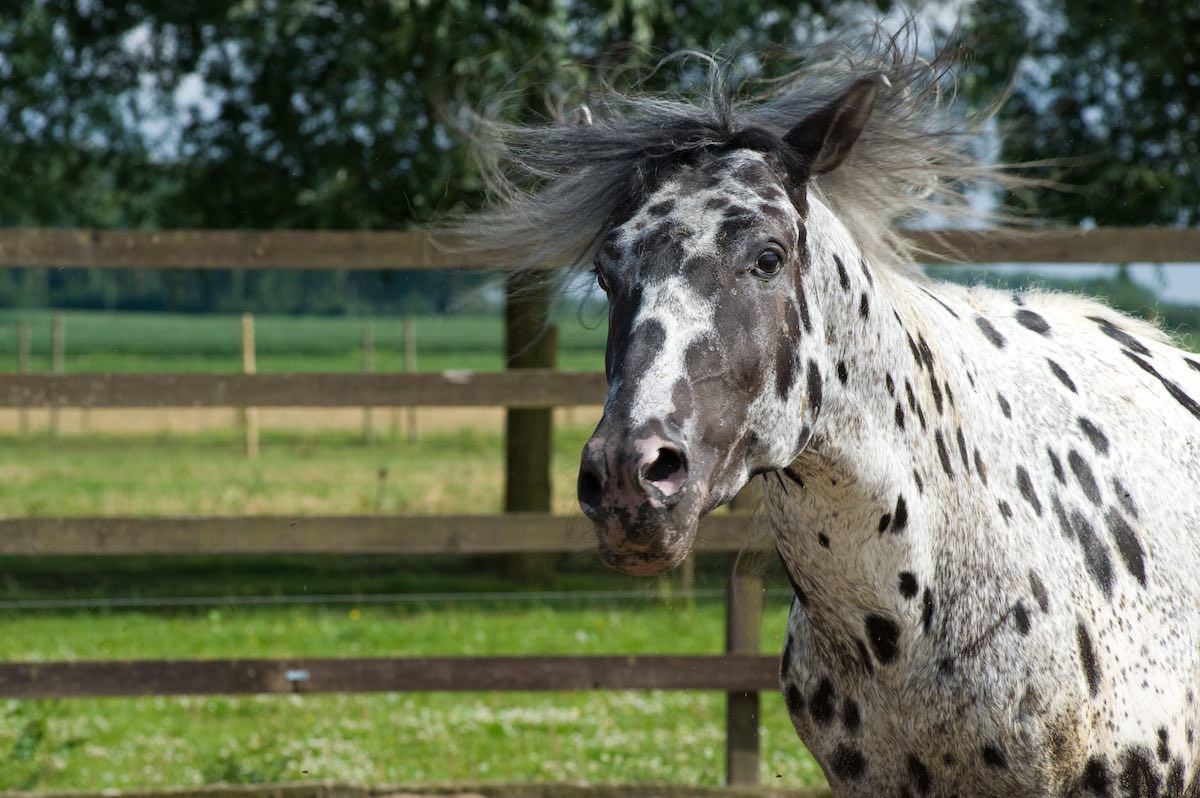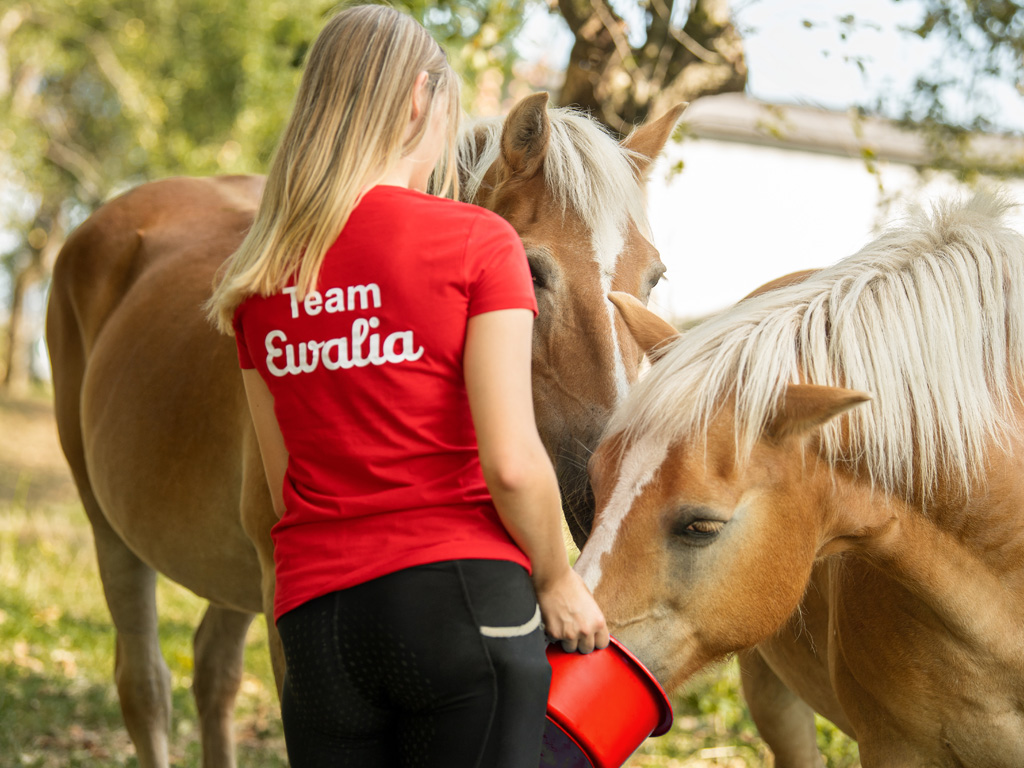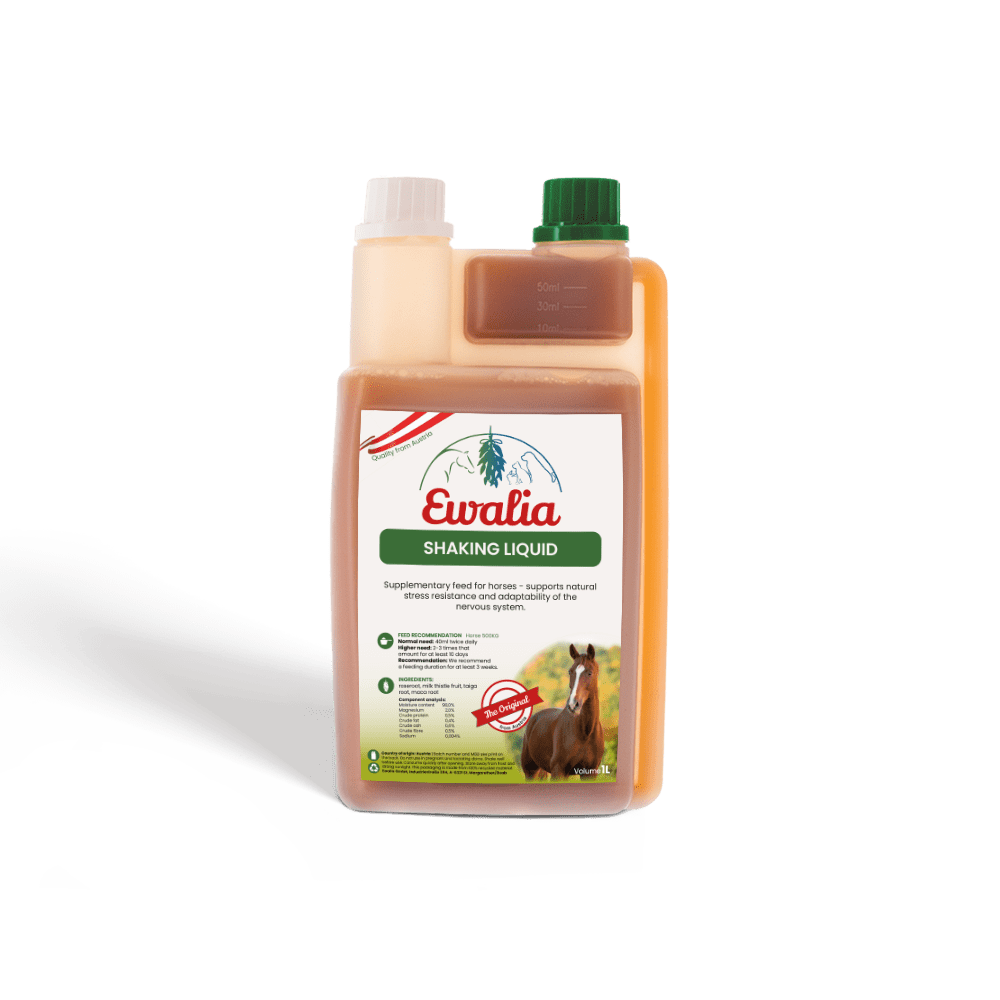Headshaking in horses

The symptom complex in horses referred to as "headshaking" comprises a variety of symptoms, from slight shaking of the head to light sensitivity, frequent snorting to uncontrollable shaking of the head and high risk of self-injury of the diseased animal. The cause and development of the disease is known only in some cases, so that treatment is only partially successful. There is hope, however, provided by the use of adaptogenic plants and herbs.
What is meant by headshaking?
Symptomatic headshaking
Depending on the symptoms, headshaking is divided into two categories: In symptomatic headshaking, dental problems, infection, allergies, brain trauma, a virus such as Borna virus, tetanus, a parasitic attack on the head by mites, for example., eye discomfort, back problems or even rideability problems may be the cause.
Idiopathic headshaking
If the causes of symptomatic headshaking have been ruled out, but the condition still occurs, it is called idiopathic headshaking. This condition is probably caused by pain signals sent to the horse's brain starting at the trigeminal nerve, which extends over the entire head of the horse. The cause is suspected to be nerve contact. An adjacent artery runs too close to the nerves and aggravates the muscle activity of various hollow organs caused by the passing blood. This also explains why the symptoms intensify during increased exertion and the accompanying increase in blood pressure.
What are the symptoms?
The shaking of the head gives the disease its name. Unlike cribbing or weaving, headshaking is not considered a behavioural disorder. Symptoms vary in severity and intensity from animal to animal. All breeds and any age can be affected. There have been occasional cases of the animal having to be euthanased, as it represented a considerable danger to humans and itself.
Typically, horses that suffer from headshaking often behave as follows:
- Reflexive headshaking and snorting
- Playing with its tongue and pulling up its upper lip (as in flehmen)
- Reaction to light (e.g. contrasts caused by shadows)
- Hypersensitivity to insects and stress situations
- Rubbing the nose or head on objects and / or on the front legs
- Clear to whitish slime from the nose, runny eyes
In most cases the symptoms of headshaking are exacerbated on warm and sunny days. Affected horses are very sensitive to light reflections such as "glittering" snow. Horses that are sensitive to light should not be put out into direct sunlight. Depending on the nature of the behavioural abnormalities, wind can severely worsen or even alleviate the symptoms. Hypersensitive reactions to movements near the head can be observed. Affected horses also often grind their noses on the ground, rub against walls, other objects or even their own front legs. In worse cases, horses have been observed to show signs of severe headache by constantly or sporadically hitting their heads against solid objects.
It has been noted in several affected horses that the symptoms start when the halter or bridle is put on already. These horses are mostly resistant to being ridden and are not very cooperative or willing to work. Jumpiness, especially when moving between areas of different brightness, has also been observed. It is also well-known that horses with this disability lose condition easily or appear exhausted, irritated or tense.
Paradoxically, many horses show little or no abnormal behaviour when going to the clinic because of the change in environment. This leads to the conclusion that the cause of the clinical picture strongly interacts with the environment, husbandry and the local (stress) situation.
What are the causes and triggers of headshaking?
Experience has shown that horses of all breeds and of all ages are affected, with increased statistical frequency in horses older than 7 years and geldings. Whether this statement is significant, it remains an open question.
Some horses shake their heads without having any health problems. But it could be caused by a faulty bridle or bit, a badly fitting saddle, being ridden too much, stress, e.g. in competitions, stable changes, the daily environment or even poor husbandry and feeding.
In veterinary circles, contact or lack of distance between the trigeminal and optic nerve is known as a remarkably common cause of idiopathic headshaking. In a worst case scenario this can lead to light sensitivity in the eye of the horse.
Nerve damage can be caused by a variety of viruses, e.g. herpes viruses or bacteria such as those causing Lyme disease and also trigger typical headshaking behaviour.
With such diverse interactions, concomitant symptoms and causalities, diagnosis and treatment remains a challenge for veterinarians and owners of affected animals.
What are the treatments and therapeutic approaches for headshaking?
Several approaches are described in the literature. Since some headshaking occurs seasonally, it has been assumed that the hormone balance may play a role as a trigger. In the course of a study, a medical team tried to use a gonadotrophin-releasing hormone vaccine in headshaking horses for relief. This was not as successful as expected, and the number of subjects was very low.
Surgical neurolysis of the trigeminal nerve was another approach. The operation was meant to relieve the pressure on and relax the stressed nerve. This would then give inflammatory processes the chance to heal. A Hannoverian gelding that was very severely affected by headshaking was selected as the subject. The post-operative phase was very onerous and painful for the horse. In the end the improvement was hardly noticeable, and the headshaking returned after a few months. No more than six months later the gelding was put down, as his quality of life was unacceptable.
In a clear case of idiopathic headshaking, a Californian team chose the approach of stimulating the nerve tracts. Using the so-called SEP test (somatosensitively evoked potentials), the affected nerve tracts are stimulated in a certain frequency range by electrodes and their values are stored and compared with those of non-diseased horses. However, this test method was unfortunately not very conclusive. What was interesting was the discovery that the affected nerves still had a high voltage despite local anaesthesia. This meant that the classical treatment of anaesthetising the trigeminal nerve was probably unsuccessful.
The classic therapeutic approaches such as analgesics or non-steroidal anti-inflammatory drugs are usually unsuccessful. Veterinarians recommend a neurectomy (chemical or surgical cutting of the nerve), which is cost-intensive and at the same time only moderately successful in the short term and not at all in the long term. Affected horse owners often search very hard for an affordable and successful alternative.
Adaptogen plants and herbs provide hope for headshaking
The term adaptogen has its literal origin in adaptation. The name describes use and effect insofar as it refers to adaptation to stress situations, unusual circumstances of physical and psychological nature. In human medicine, adaptogens are used for stress, anxiety and sleep disorders, but they are not completely unknown in veterinary medicine. In this respect, ginseng is the best known example from naturopathy and is generally considered to be tonifying and invigorating. It mobilises the body's own defences and much more.
Biologically active phytochemicals with an adaptogenic effect, such as rose root, affect the so-called "happiness hormones" such as serotonin, which in turn influences the tension of blood vessels. Combinations of different adaptogenic herbs are also considered as tonics.
An example of this combination would be taiga root, maca root and rose root, the effects of which are briefly outlined in detail below:
Taiga root
Taiga root is known for its invigorating, stimulating and immune-system-stimulating effects. In animals as well as in humans an increase in performance and concentration could be observed when ingesting taiga root
Maca root
Originally from South America, the maca root (root tuber) is known to provide energy to the body and increase endurance and resilience.
Rose root
Rose root is used for poor concentration, sleep disorders and mild depression because it positively influences the release of endorphins as well as the dopamine and serotonin levels. A mixture or a highly concentrated extract of the adaptogenic plants and herbs mentioned can provide relief for headshaking horses and thus increase the quality of life of the affected animals.
Compiled by: Bianca Becker-Slovacek on 21/02/2019
Bibliography and further reading
- Aleman, M., Rhodes, D., Williams, D., Guedes, A., & Madigan, J. (September 2014). Sensory Evoked Potentials of the Trigeminal Nerve for the Diagnosis of Idiopathic Headshaking in a horse. J Vet Intern Med 28, p. 250-253.
- Bell, C., Hnenny, L., & Torske, K. (July 2018). Internal neurolysis of the maxillary branch of the trigeminal nerve for the treatment of equine trigeminal mediated headshaking syndrome. Can Vet J VOL59, p. 763-769.
- Gerber V., Venner, M., & Straub R. (2016): Equine diseases. Internal Medicine (2nd edition) (V. Gerber, & R. Straub, eds.) Bern: utb.
- Knottenbelt, D. (no date). http://www.equinedental.com.au/. Accessed from https://www.google.com/url?sa=t&rct=j&q=&esrc=s&source=web&cd=10&ved=2ahUKEwjAgOaC8Z_iAhXB8uAKHR_PAZQQFjAJegQIABAC&url=http%3A%2F%2Fwww.equinedental.com.au%2Fwp-content%2Fuploads%2F2016%2F02%2FHeadshaking-EQUINE-FORUM-2012.pdf&usg=AOvVaw3qHYNY3ntV-IRsWWfT
- Pahlow, M. (2013): The big book of medicinal plants. Hamburg: Nikol Publishers.
- Pickles, K., Berger, J., Davies, R., Roser, J., & Madigan, J. (Jänner 2011). Use of a gonadotrophin-releasing hormone vaccine in headshaking horses. Veterinary Record 1/8, p. o.p.
- Talbot, W., Pinchbeck, G., Knottenbelt, D., Graham, H., & McKane, S. (2013). A randomised, blinded, crossover study to assess the efficacy of a feed supplement in alleviating the clinical signs of headshaking in 32 horses. Equine Veterinary Journal 45, p. 293-297.
- Tomlinson, J., Neff, P., Boston, R., Aceto, H., & Nolen-Walston, R. (5 September 2013). Treatment of Idiopathic Headshaking in Horses with Pulsed High-Dose Dexamethasone. J Vet Intern Med 57, p. 1551-1554.
- Winter, J. C. (2009). Untersuchung zur Wirkungsweise einer Glyzerolinjektion an das Ganglion trigeminale als Grundlage einer Behandlung des Headshakings beim Pferd [Investigation of the mode of action of a glycerol injection to the ganglion trigeminal as the basis of a treatment of headshaking in horses] Hannover: Veterinary University of Hannover.














